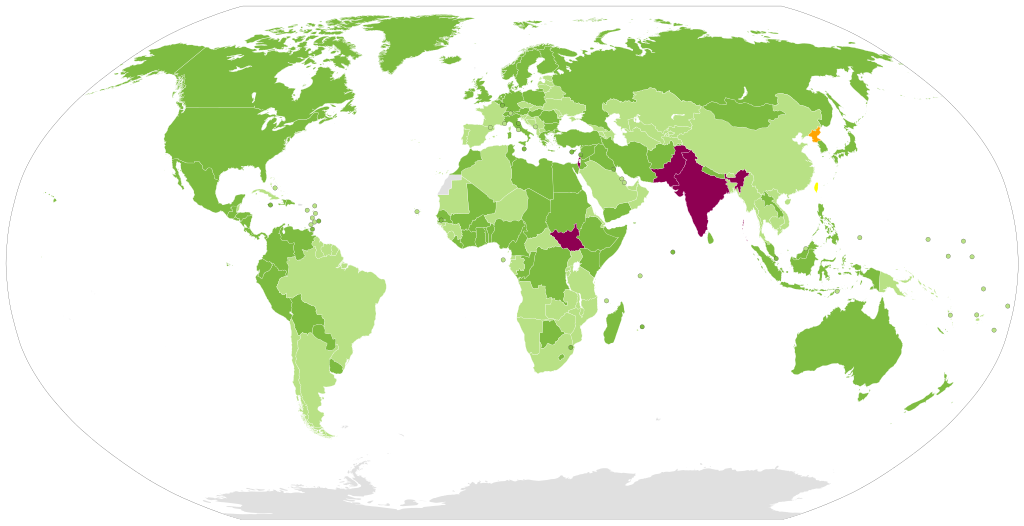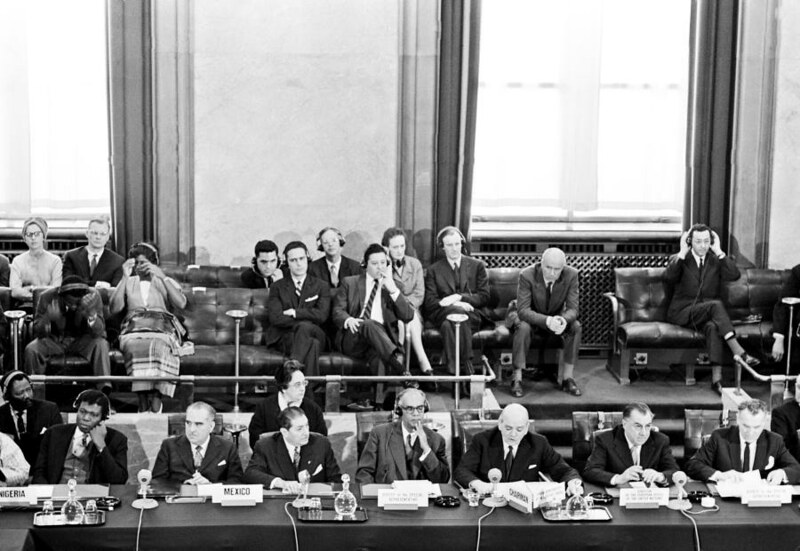The ‘Demonstration’ That Was India's Peaceful Nuclear Explosion
On May 18, 1974, so nuclear myth-making goes, the Buddha smiled. This is said to be the code used to inform Prime Minister Indira Gandhi of the successful nuclear test at Pokharan, though all involved have denied it, offended at the suggestion that they might knit together the apostle of peace with atomic destruction.
(The association might have faded but for the irony of India’s second test, twenty-four years later, again falling on Buddha Jayanti.)
Fifty years later, the myth-making continues as India’s nuclear programme is co-opted into visions of a ‘strong’ India, especially with the BJP brandishing India’s nuclear arsenal against India’s western neighbour in the current election campaign.
The BJP would of course burnish its nuclear credentials, as nuclear rhetoric has been part of its idea of India for decades. It is therefore ironic that the myth-making started with a Congress government.
At the time, though, there was ambivalence about testing in 1974. As Raja Ramanna (then director of the Bhabha Atomic Research Centre) recorded in his autobiography, Gandhi gave the final go-ahead for a ‘peaceful nuclear explosion’ (PNE) in early 1974, overriding opposition from her closest political advisors, P.N. Haksar and D.P. Dhar, who harboured reservations over India’s economic resilience and ability to withstand the political fallout of a test.
However, in the end, Gandhi decided that the test, which had been in preparation from late 1972, should go ahead because “India required such a demonstration”. What was this a demonstration of?
Today, as India goes to the polls with ideas of security becoming ever more politically contested, it is worth revisiting the 1974 test and the different meanings of security that fed into India’s PNE.
Little is recorded about the decision to test. Gandhi documented her assent after the explosion. According to K. Subrahmanyam, Morarji Desai’s Janata government, which succeeded the Congress in 1977, looked for files and came away empty handed.
Yet, there are clues to this ‘demonstration’ in the lead-up to the test. They can be summed up in the shorthand of dates: 1971 and 1968; but also 1966, and 1972-73.

India is among four countries that have not signed the NPT (red). Photo: Allstar86/Wikimedia Commons. CC BY-SA 3.0.
From this perspective, the really big story of 1971 was not the liberation of Bangladesh but the sailing of the US Seventh Fleet, led by the nuclear-powered Enterprise.
Historians still debate why Richard Nixon sent the Enterprise into the Bay of Bengal after war broke out between India and Pakistan. Whatever his thinking, as far as India was concerned the crude nuclear blackmail that India had anticipated after the first Chinese test over Lop Nur came not from Beijing but from Washington, the capital that had, until then, offered to help India counter China’s nuclear ambitions.
In its own way, the Enterprise’s sailing was a demonstration, one that cast a shadow for a quarter of a century over India-US relations.
Before that, in 1968, when the Nuclear Non-Proliferation Treaty (NPT) opened for signatures, India, having negotiated the treaty at the Eighteen Nation Disarmament Commission (ENDC) from 1962, decided not to sign.
Gandhi explained India’s abstention in the Lok Sabha in April 1968 as “driven by our self-enlightenment”. Speaking to the press, she declared, “Aid or no aid, India will not sign the non-proliferation treaty.”
Not signing the NPT became synonymous with India managing its own self-interest – even though it was not clear then whether India’s interests lay in adopting nuclear weapons.
As Gandhi had stated a year earlier in the Lok Sabha (by which time it seems that she and her government were leaning away from acceding to the treaty):
We think that nuclear weapons are no substitute for military preparedness, involving conventional weapons. The choice before us involves not only the question of making a few atom bombs, but of engaging in an arms race … Such a course, I do not think would strengthen national security.
On the other hand, it may well endanger our internal security by imposing a very heavy economic burden which would be in addition to the present expenditure on defence.
…Nothing will better serve the interests of those who are hostile to us than for us to lose our sense of perspective and to undertake measures which would undermine the basic progress of the country.

“The civil nuclear powers,” Indian ambassador V.C. Trivedi remarked to the ENDC in 1967, “can tolerate a nuclear weapon apartheid but not an atomic apartheid in their economic and peaceful development.” Representative image. Photo: United Nations Photo/CC BY-NC-ND 2.0.
Adding another layer of meaning to India’s rejection of the NPT was its negotiating stance at the ENDC. Indian negotiators emphasised that the NPT governed not just nuclear weapons, but the very structuring of international relations. India’s ambassador V.C. Trivedi insisted early on that India’s stance “will reflect our attitudes and approaches on international relations in general”.
This made it vital that the negotiations respect “the sovereign equality of all nations and the principles of equality and mutual benefit”.
Nuclear technology had become a sticking point because the emerging treaty appeared to give nuclear powers control over the spread of the peaceful atom. India countered these efforts forcefully.
“The civil nuclear powers,” ambassador Trivedi remarked to the ENDC in 1967, “can tolerate a nuclear weapon apartheid but not an atomic apartheid in their economic and peaceful development.”
This speech all but sealed India’s chances of signing the NPT the following year.
The focus on development, however, raised the ghost of other dates. In 1966, Indira Gandhi became prime minister of a country that was reeling from two recent wars, a balance of payments crisis and a drought.
The increasing trade deficit and worsening inflation, compounded by the cutting off of foreign aid (partly because of the 1965 war and partly to pressure India into liberalising), left Gandhi with no choice but to carry out a move that had been planned by her predecessor.
In June 1966, the rupee was sharply devalued, leaving the dollar 57% more expensive. It was a deeply unpopular measure, and she suffered the political consequences.
Adding to the government’s troubles, after the failed monsoons of 1965 and 1966, India was dependent on food aid, living, as some acidly remarked, from “ship to mouth”.
US President Lyndon Johnson is said to have personally cleared each shipment under America’s PL480 programme, extracting concessions from New Delhi on agricultural and economic policies in return for a month’s grain.
There was bitter resentment over India’s vulnerability, but resentment would not fill bellies.
Also in 1966, following Homi Bhabha’s death, Vikram Sarabhai became Chairman of the Atomic Energy Commission and immediately faced pressure to respond to China’s ongoing nuclear tests with something suitably atomic.
With Gandhi’s backing, Sarabhai faced down calls for a nuclear test, instead focussing on improving the underperforming civil nuclear programme. At his first press conference he was blunt about India’s requirements, reminding Indians that “security” also depended on “the economic development of the nation”, a balancing of “national resources for productive and social welfare against the burden of defence expenditure”.
In these circumstances he cautioned against a symbolic nuclear test, for “paper tigers do not provide security, that is, you cannot bluff in regard to your military strength”. He then went on to spell this out: “It is not only for the scientist to produce one prototype, and you then have a defence system. It requires a total commitment of national resources of a most stupendous magnitude…”
At this stage, Gandhi and Sarabhai had made it clear that tokenism and display alone would not make India any safer. A nuclear weapons programme would require a massive diversion of economic resources – resources that were urgently required elsewhere to provide a basic standard of living for all.
Sarabhai’s death in late 1971 provided the nuclear establishment, now led by Homi Sethna, with a new opportunity to revisit testing; in mid-1972, Gandhi agreed to a test.
Thereafter, a series of incremental decisions further advanced preparations at a time when India was grappling with the fallout of the Bangladesh crisis and a series of oil shocks in 1972-73, both of which might have necessitated against a test by adding to India’s economic burdens.
The nuclear establishment perhaps believed that this was the first of a series of tests, but after Pokharan I, Gandhi shut down all conversation of weapons and further tests.
“There is nothing to get excited about,” she said at a press conference. “This is part of our normal research and study.”
Facing parliament, she explained, “No technology is evil in itself … India does not accept the principle of apartheid in any matter and technology is no exception.”
Demonstrations are vulnerable to interpretation. Just asserting India’s sovereign right to choose its nuclear future did not necessarily provide India with deterrence or abundant nuclear energy. Indeed, Canada immediately cut off all nuclear cooperation, thereby halting progress on two nuclear power plants.
The test did not even provide Gandhi with political cover. She enjoyed a short boost to her popularity (which had been plunging by mid-1974), but that did not last the year. Her continuing political travails eventually led her into declaring the Emergency a year later – in its own way, yet another demonstration, and one that has defined her legacy.
Having demonstrated India’s independence, New Delhi spent the following decades shoring up India economically and diplomatically – an exercise complicated by strong international reactions to the test.
Half a century later, India is faced with other demonstrations and assertions as it goes to the polls. Yet, declarations of today’s India having arrived on the global stage because of its size, culture, politics and manifest destiny, to say nothing of its nuclear weapons, will ring hollow unless its democracy delivers to every citizen of India.
Then perhaps the Buddha might indeed smile.
Priyanjali Malik is an independent researcher who primarily focuses on security and politics in the Indian subcontinent.
This article went live on May eighteenth, two thousand twenty four, at twenty-seven minutes past four in the afternoon.The Wire is now on WhatsApp. Follow our channel for sharp analysis and opinions on the latest developments.




